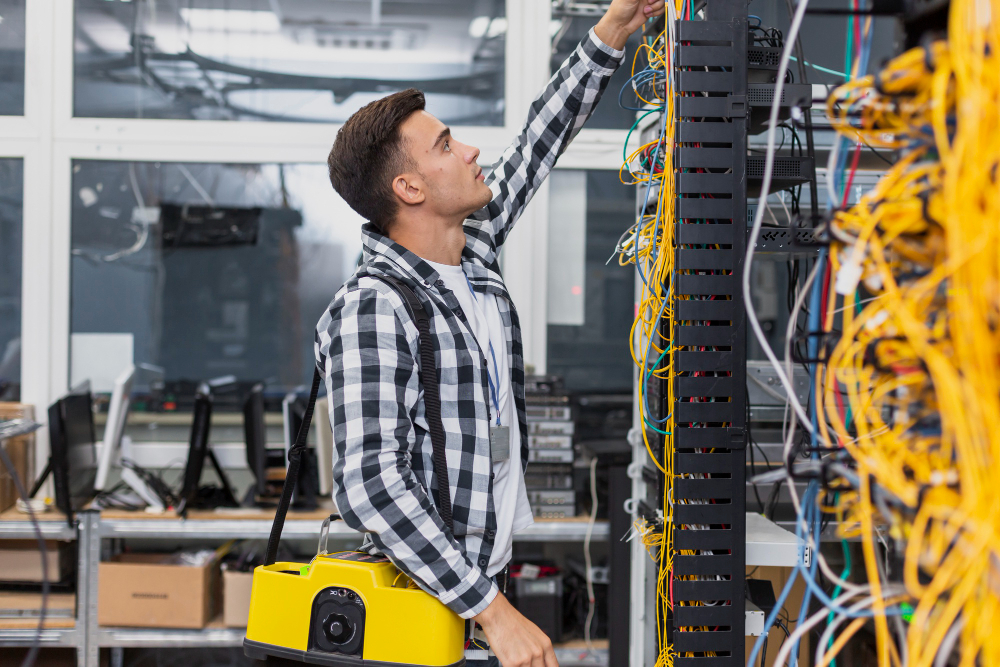Best Network Cabling Options for Small Offices

Your network cabling is the backbone of your operations, determining everything from efficiency to productivity. Modernization is nonnegotiable since high-speed connectivity is essential for business-critical applications. The quality of your structured cabling system depends on who installs it, so you should consider your options carefully. The best network cabling options for small offices are professionally engineered and installed. Custom, expertly installed systems perform better and last longer than cheap, off-the-shelf solutions. No matter the size of your business, you deserve a reliable, high-quality structured system.
1. Kirbtech
As a local organization with 15 years of expertise, Kirbtech provides the best network cabling options for small offices. It offers fiber-optic and Ethernet solutions, including category (CAT) 5, CAT6 and CAT6a. These options make the most sense for a business of your size, letting you future-proof your system without incurring unnecessary costs for bandwidth or data transfer speeds.
Once your structured cabling system is installed, these experts can help you with management if you lack an in-house team. The process begins with a complimentary consultation, during which they create a custom plan. They can handle network administration, operation, provisioning, security and maintenance. You can use any combination of services you would like.
Key Services
- Free network assessment: An IT infrastructure evaluation for customized support
- Structured cabling installation: Wi-Fi infrastructure build-out and data cabling
- Managed IT services: Technical support, data security and preventive maintenance
2. TELECO
For around 45 years, TELECO has developed high-quality data and voice cabling solutions for small and medium-sized businesses in Florida and South Carolina. It starts with a free network infrastructure assessment, where it surveys your network and cabling components, including routers, switches and Wi-Fi access points.
Since structured cabling can account for almost 80% of your network’s efficiency, future-proofing your system is crucial. Many of the networks TELECO encounters operate at under 100 Megabits per second (Mbps), which experts consider very slow for the amount of bandwidth today’s applications require. It can help you reach 10 Gigabit per second (Gbps) using Ethernet or fiber network cables.
Key Services
- Structured cabling consultation: A free infrastructure review to determine your needs
- Network cabling installation: CAT5e, CAT6, coaxial or fiber-optic cable installation
- Equipment-as-a-service program: Priority scheduling for repairs and upgrades
3. The Network Installers
With multiple locations throughout California, The Network Installers can guarantee fast response times. It also offers top-rated wiring and network solutions, boasting a 99% satisfaction rating over 20,000 jobs. Its certified, experienced field technicians design and install structured cabling solutions for offices.
This company’s cost and timeline estimates are 90% accurate because they are based on on-site walk-throughs. Professionals can provide multiple estimates for a basic Ethernet system or more complex installations with additional features. Your options include fiber-optic, CAT5, CAT6 and CAT8 cables, plus optional hardware add-ons.
Key Services
- Free on-site consultation: A walk-through for accurate project estimates
- Structured cabling installation: Engineer-led cabling system design and installation
4. iFeelTech
Miami-based iFeelTech has over 15 years of experience serving hundreds of small and midsized businesses. While it provides everything from IT consulting to same-day technical support, it specializes in network infrastructure projects for those with 10 to 100 employees. The team designs enterprise-grade wired networks to provide scalability and eliminate connectivity issues.
Its process begins with a no-obligation review, where it evaluates your network performance based on your office size, business needs and growth goals. With this information, it can develop a system configuration that checks every box. Since it offers flexible scheduling to minimize disruption, you can have the team work on evenings or weekends.
Key Services
- Free technology assessment: A complimentary review of your network performance
- Structured cabling installation: CAT6 or fiber-optic cable installation
- Managed IT services: Ongoing technical support with same-day services
How We Chose the Best Network Cabling Solutions
Variety gives you flexibility, so providers offering multiple network solutions for small businesses automatically rank higher. Those offering fiber-optic and Ethernet are the best because you get a range of performance, speed and price options. Coaxial, twisted pair and specialized cabling options are of lesser importance, but still significant considerations.
It is not enough to have the type of network cable you want — organizations must know how to install it. The chosen professionals have decades of experience completing projects for small and midsized businesses. This distinction is crucial because enterprise-grade setups are in an entirely different league.
Another deciding factor was the option for on-site information technology (IT) consultations. Over-the-phone estimations are more convenient to collect, but they are rarely precise, which can adversely affect your cash flow during implementation. Installation professionals who walk through your office can accurately assess the project’s cost and turnaround time.
Cost is the last criterion. As a small business, you may have a variable cash flow, so you must be smart with your investments. Providers had to offer free assessments, consultations or onboarding to make this list. Also, they had to provide transparent, reasonable cost estimates.
Compare These Network Cable Installers at a Glance
Network cabling options vary, even among the best of the best businesses. Which one should you pick? If you need help deciding, consult this comparison table. It lays out services, experience and perks in a straightforward visual format to simplify decision-making. It will help quickly narrow your choices, making it easier for you to contact your top picks directly.
| Cabling Installer | Kirbtech | TELECO | The Network Installers | iFeelTech |
| Network Cable Types | Fiber-optic and Ethernet | Fiber-optic, Ethernet, coaxial | Fiber-optic and Ethernet | Fiber-optic and Ethernet |
| Industry Experience | Almost 20 years | Almost 45 years | Almost 20 years | Over 20 years |
| Free Network Assessment | ✔ | ✔ | ✔ | ✔ |
| Custom Designs | ✔ | ✔ | ✔ | ✔ |
| Prompt Response Time | ✔ | ✔ | ✔ | ✔ |
| Managed IT Services | ✔ | ✔ | ✘ | ✔ |
| After-Hours Support | ✔ | ✘ | ✘ | ✔ |
Remember to review each company thoroughly before making a selection. This table may make the decision seem cut and dry, but it is only for an at-a-glance comparison — there are many more factors to consider.
Request on-site walk-throughs or consultations for project cost and timeline estimates tailored to your business needs. Talking directly to representatives who understand what you are looking for can ensure you get the proper cabling system. They can also give you a more accurate view of what your project might cost, as each client requires a unique installation. Getting quotes from multiple providers also shows you where you save money and avoid cutting corners.
There is more to your investment than installation, so you should consider post-installation services. Even if you have an in-house team, it is advisable to receive ongoing support from one of these providers. Outsourced experts can cover your technical, data security and maintenance needs for less than it costs to cover employees’ payroll and equipment expenses.
Signs the Office Needs a Structured Cabling Upgrade
Have you noticed slow internet speeds, frequent connection drops or visible cable damage? Those are signs that the office’s structured cabling infrastructure can no longer keep up with demand, indicating it is time to upgrade.
Even if you have not experienced connectivity issues, you should consider upgrading if you still use legacy systems. Older solutions no longer meet industry standards and are often incompatible with newer equipment. The technology has advanced significantly in the past few decades, going from supporting around 10 Mbps to 10,000 Mbps.
As you expand operations and install new devices, your network cabling system must also evolve. In addition to eliminating connectivity issues, you would benefit from lower latency, better performance and faster data transmission rates.
What Are the Core Components of Structured Cabling?
Unlike conventional point-to-point cabling, structured cabling does not connect network components through a single wire. Instead, it comprises a series of wires that connect directly to network servers and switches through flexible pathways. They run throughout the building to ensure predictable, efficient network performance.
This type of building cabling infrastructure consists of multiple rooms, collections of cables and work areas. The entrance facility contains all the components required to connect the office’s private cabling system to outside providers. Vertical and horizontal cabling connect rooms and even separate buildings on the same campus through wall and floor penetration sleeves.
The Different Types of Networking Cables Explained
The four primary network solutions for small businesses include Ethernet, fiber-optic, twisted pair and coaxial cables. Each one has different properties, costs and data transmission rates.
Ethernet Cables
Ethernet cables comprise eight insulated copper wires twisted into four pairs within a plastic sheath. They are twisted at different rates to minimize internal electromagnetic interference, reducing signal loss and improving performance.
Fiber-Optic Cables
In fiber-optic cables, pulses of light travel through a glass core to transmit data. Specialized hardware transforms those signals into ones and zeroes that are machine-readable. The unique core material, cladding, buffer and jacket make this network cabling type immune to electromagnetic interference.
Unlike single-mode fiber, multimode fiber uses multiple rays of light. The former is ideal for long distances, while the latter is best for higher throughput. Both support high bandwidth and data transmission rates, making them suitable for connecting multiple departments or buildings.
Compared to other options, fiber offers the best performance and uptime. Since it utilizes a glass core and is laid underground, it is unaffected by severe weather or electrical interference. However, it can be expensive and challenging to install, especially in the colder months. Installation requires trenching since the cables must be buried.
Twisted Pair Cables
Twisted pair cables are often used in local area networks and telecommunication systems. They consist of pairs of insulated copper wires twisted together. The shielded version wraps foil around each group for additional protection. Unshielded wires are less protected but typically more affordable.
Coaxial Cables
Coaxial cables consist of an outer metal sheath, an insulating plastic layer and a solid copper core. It can come in single-core or multicore configurations. Traditionally, it is used for television and broadband networks because it can carry high-frequency signals over long distances. While some consider it outdated, it is still widely used in networking applications.
The Differences Between Ethernet Cable Categories
There are many types of Ethernet cables, each with unique capabilities. They are arranged in a category system that ranges from CAT1 to CAT8 as of 2025. This variety gives you more flexibility, making it easier to find something that aligns with your needs and budget. To understand which meets your needs best, you must understand their differences.
While the scale goes down to CAT1, modern businesses go no lower than CAT5. CAT4 was once considered standard but is now obsolete since it only supports a data transfer rate of 100 Mbps. CAT5 can handle gigabit internet, enabling high-speed communications.
CAT6 has a better data transfer rate, is more affordable, meets today’s building code standards and is backward compatible with older Ethernet standards, so it is the most popular variant in use. It enables up to 10 Gbps speeds at a maximum range of 55 meters. CAT6a supports double the distance, making it great for demanding networking environments.
CAT7 is considerably faster but is uncommon because it is technically not the successor to CAT6. It is not an official Institute of Electrical and Electronics Engineers (IEEE) cabling standard. CAT8 is recognized by the IEEE and is compatible with all previous generations. It can achieve high throughput over short distances, so it is ideal for smaller organizations.
Deciding on Network Solutions for Small Businesses
For small businesses, network solutions are more than backend hardware — they are the foundation of success. Your bandwidth, latency, and data transmission rate impact your office’s productivity, efficiency and operational costs. Upgrading your cabling infrastructure is essential, whether you employ 10 people or 100.
You deserve access to the same solutions that large enterprises depend on for their success. With help from the best network cabling options for small offices, you can. Their decades of expertise and on-site assessments will help you determine how to best upgrade your infrastructure. Some will even perform the installation after hours to minimize disruption to your workflows.






